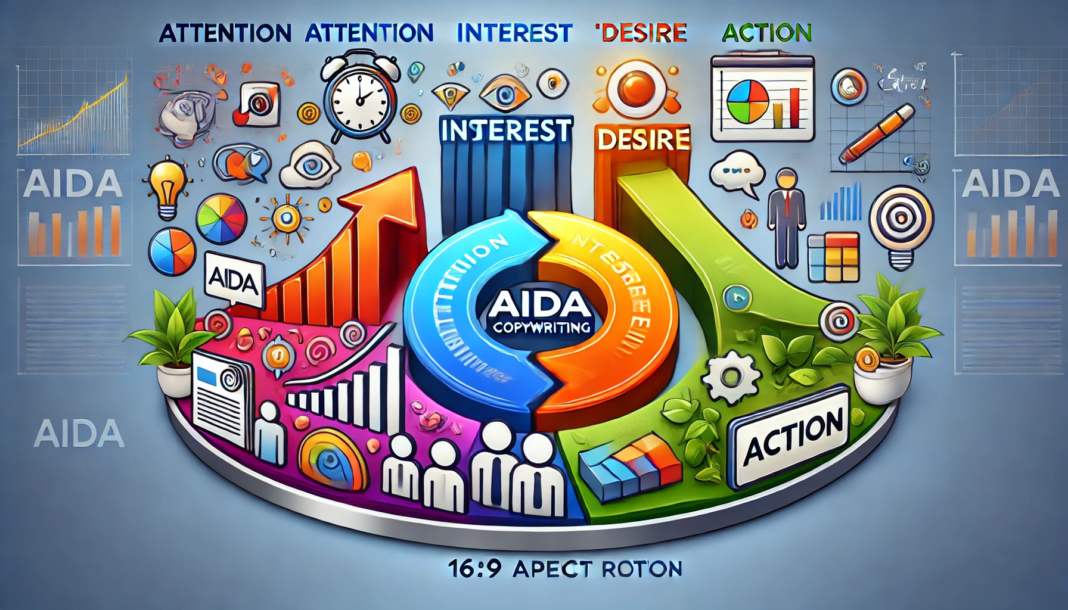The AIDA model is a classic framework in copywriting and marketing, guiding professionals in crafting compelling messages that drive consumer action. The acronym AIDA stands for Attention, Interest, Desire, and Action, representing the four stages a potential customer goes through when interacting with marketing content. This article delves into each component of the AIDA formula, exploring how it can be effectively applied to various forms of copywriting.
Understanding the AIDA Formula
The AIDA formula is a tried-and-true method used to create persuasive communication. It’s widely employed in advertising, sales, and public relations to engage and convert prospects. The model’s simplicity and clarity make it an invaluable tool for marketers aiming to optimize their messaging strategies.
Attention: Capturing the Audience’s Focus
The first step in the AIDA formula is to grab the audience’s attention. In an era saturated with information, capturing attention is more challenging than ever. This can be achieved through various means, such as eye-catching headlines, striking visuals, or thought-provoking questions.
- Headline Crafting: A headline is often the first thing a reader sees, making it crucial for grabbing attention. It should be clear, concise, and intriguing, compelling the reader to delve deeper into the content.
- Visual Elements: Images, videos, and graphics can also play a significant role in capturing attention. Visual content is processed faster by the brain, making it an effective tool for engagement.
- Questions and Exclamations: Starting with a question or a bold statement can pique curiosity. It encourages readers to seek answers, drawing them further into the content.
Interest: Engaging the Audience
Once attention is secured, the next step is to maintain the audience’s interest. This involves providing relevant and engaging content that resonates with the audience’s needs and desires.
- Storytelling: Stories are a powerful way to connect with the audience on an emotional level. They make the content relatable and memorable, enhancing engagement.
- Benefits Over Features: Rather than listing features, focus on the benefits the audience will gain. This helps in creating a connection between the product or service and the consumer’s needs.
- Personalization: Tailoring the message to the target audience can significantly increase interest. Use language, examples, and scenarios that resonate with the specific demographic you are addressing.
Desire: Creating a Want
After capturing interest, the next goal is to cultivate desire. This stage involves convincing the audience that they not only want but need the product or service.
- Highlighting Unique Selling Points (USPs): Clearly outline what sets your product or service apart from the competition. Highlighting the unique benefits can create a strong desire.
- Social Proof: Testimonials, reviews, and case studies provide credibility and can significantly boost desire. They show potential customers that others have benefited from the product or service.
- Scarcity and Urgency: Limited-time offers or exclusive deals can create a sense of urgency. This psychological trigger can compel the audience to act swiftly, fearing they might miss out.
Action: Prompting the Audience to Act
The final step in the AIDA formula is prompting the audience to take action. This could be making a purchase, signing up for a newsletter, or contacting the company. The call to action (CTA) should be clear, compelling, and easy to follow.
- Clear CTAs: A good CTA tells the audience exactly what to do next. It should be simple, direct, and focused on a single action, like “Buy Now” or “Subscribe Today.”
- Ease of Action: The process to take action should be as smooth as possible. Any friction, such as complicated forms or unclear steps, can deter potential customers.
- Follow-up: After the initial action, a follow-up can help maintain engagement. This could be a thank-you email, additional information, or an offer for further interaction.
Applying AIDA in Digital Marketing
In digital marketing, the AIDA formula can be applied across various platforms, from social media to email campaigns. Its flexibility makes it a versatile tool for crafting messages that resonate with different audiences.
- Social Media: On platforms like Facebook and Instagram, the AIDA formula can guide the creation of engaging posts and advertisements. Attention-grabbing visuals and concise captions can hook users, while targeted ads can sustain interest and drive action.
- Email Marketing: In emails, the subject line serves as the “Attention” grabber, the content body maintains “Interest,” and the CTA prompts “Action.” Personalization and segmentation can further enhance the effectiveness of this approach.
- Web Content: Websites can use the AIDA model to guide visitors through a seamless experience, from the landing page to the checkout process. Clear navigation, compelling copy, and strategic CTAs are key components.
AIDA in Traditional Advertising
While digital channels dominate today’s marketing landscape, traditional advertising still has a place. The AIDA formula can be effectively applied to print ads, television commercials, and even billboards.
- Print Ads: In magazines and newspapers, AIDA can guide the layout and copy. A striking headline and engaging image capture attention, while concise copy maintains interest and prompts action through coupons or contact information.
- Television and Radio: In these mediums, the first few seconds are crucial for grabbing attention. Engaging scripts and visuals, combined with a strong CTA, can drive audience action.
- Outdoor Advertising: Billboards and transit ads require brevity. The AIDA model helps in crafting concise messages that capture attention and convey the desired action quickly.
Challenges and Limitations of AIDA
While the AIDA model is effective, it is not without limitations. It primarily focuses on the linear journey of the consumer, which may not reflect the complexity of modern buying behavior. Moreover, it assumes a passive audience, whereas today’s consumers are more informed and engaged.
- Evolving Consumer Behavior: With the rise of digital channels, consumers now have more control over their buying journey. They actively seek information, compare options, and read reviews before making decisions.
- Non-linear Journeys: The AIDA model’s linear approach may not accommodate the non-linear paths that consumers often take. They may jump back and forth between stages, influenced by multiple touchpoints.
- Integration with Other Models: To address these limitations, AIDA can be integrated with other models like the Customer Decision Journey (CDJ) or the 4Ps (Product, Price, Place, Promotion). This integration provides a more holistic view of the consumer experience.
Case Studies: AIDA in Action
Examining real-world examples can provide valuable insights into the practical application of the AIDA formula.
- Case Study 1: Coca-Cola: Coca-Cola’s “Share a Coke” campaign effectively utilized the AIDA model. The personalized bottles grabbed attention, the novelty of finding one’s name on a bottle maintained interest, the idea of sharing created desire, and the CTA encouraged purchase.
- Case Study 2: Nike: Nike’s “Just Do It” slogan exemplifies the AIDA model. The phrase captures attention, the stories of athletes maintain interest, the aspiration to excel creates desire, and the CTA in the form of purchase or participation in campaigns prompts action.
The Future of AIDA in Marketing
As marketing continues to evolve, the AIDA model remains relevant but must adapt to changing consumer dynamics. The rise of digital and social media, along with advancements in technology like AI and data analytics, presents new opportunities and challenges.
- Personalization and AI: The use of AI in personalization can enhance the AIDA model’s effectiveness. Tailored messages can capture attention and maintain interest more effectively.
- Interactive Content: Interactive content, such as quizzes and polls, can make the AIDA process more engaging. It allows for real-time feedback and a more immersive experience.
- Sustainability and Ethics: Modern consumers are increasingly concerned with sustainability and ethical practices. Addressing these concerns can create desire and drive action, aligning brand values with consumer expectations.
Conclusion
The AIDA formula is a foundational model in copywriting and marketing, offering a straightforward approach to crafting persuasive messages. By focusing on Attention, Interest, Desire, and Action, marketers can effectively guide consumers through the decision-making process. However, as consumer behavior evolves, it is essential to adapt and integrate AIDA with other models to create a comprehensive marketing strategy.
FAQ Section
What does the AIDA model stand for?
The AIDA model stands for Attention, Interest, Desire, and Action. It is a framework used in marketing and advertising to guide the creation of persuasive messages that lead potential customers through a journey from awareness to purchase.
How can I use the AIDA formula in email marketing?
In email marketing, the AIDA formula can be applied by crafting an engaging subject line to capture attention, using compelling content to maintain interest, highlighting benefits to create desire, and including a clear call to action to prompt immediate response.
What are the limitations of the AIDA model?
The AIDA model’s limitations include its linear approach, which may not reflect the complexity of modern consumer behavior, and its assumption of a passive audience. Consumers today are more informed and actively seek out information, making it essential to adapt the model to suit current trends.
Can the AIDA model be used in digital marketing?
Yes, the AIDA model is highly applicable in digital marketing. It can guide the creation of content for social media, email campaigns, and websites, helping to engage and convert users effectively.
What is the role of storytelling in the AIDA model?
Storytelling plays a significant role in the AIDA model, particularly in the Interest and Desire stages. It helps to engage the audience emotionally, making the message more relatable and memorable, which in turn fosters a stronger desire for the product or service.
How does the AIDA model relate to customer decision-making?
The AIDA model outlines the stages a customer goes through from becoming aware of a product to making a purchase decision. It mirrors the customer decision-making process, making it a valuable tool for understanding and influencing consumer behavior.

